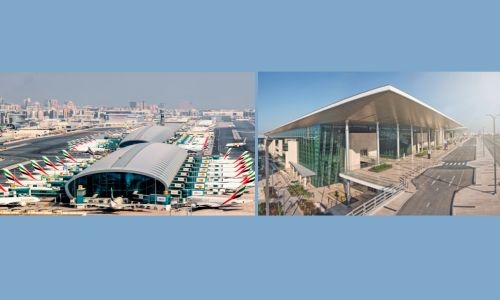Middle East prepares for takeoff with major airport expansions)
AFP | Dubai, United Arab Emirates
The Daily Tribune – www.newsofbahrain.com
With major new airports emerging from the desert and aircraft orders rolling in, the resource-rich Gulf is raising its stake in an industry forecast to boom in the decades ahead. As the International Air Transport Association’s AGM takes place this week in Dubai -- two years after it was held in Qatar -- billions of dollars are being poured into aviation around the wealthy region.
And with good reason: according to the global industry body, Middle East passenger traffic will double in the next 20 years, climbing to 530 million passengers by 2043.
Global figures will see a similar rise.
Dubai, which is already home to the world’s busiest airport by international traffic, has started work on an even larger airport which authorities say will handle up to 260 million passengers annually, which would be the biggest in the world.
A short drive away, the United Arab Emirates’ capital Abu Dhabi opened a new terminal in November, while gas-rich Qatar has also been expanding Doha’s Hamad International Airport.
Neighbouring Saudi Arabia, which is pouring its oil wealth into projects that will help it weather the clean energy transition, is also making a major play.
Along with announcing a new air hub in Riyadh with capacity for 120 million passengers a year, Saudi Arabia has also unveiled Riyadh Air, a new airline with 39 Boeing jets on order.
Meanwhile, Jeddah-based Saudia Group, which runs the Saudia and flyadeal carriers, announced a bumper deal for 105 Airbus aircraft last month.
Emirates, Dubai’s state-owned carrier, with its large fleet of longrange, wide-body aircraft, epitomises the Gulf’s “ huband spoke” model in which a globe-spanning range of longhaul destinations are linked by connecting flights through Dubai.
The Gulf “is a unique region due to its geography. In an eighthour flight, we can reach 80 percent of the world’s population”, explained Stan Deal, then head of Boeing’s commercial aircraft division, late last year.
‘A ton of growth’
While Asia is expected to drive the rise in global passenger traffic, the Gulf expects to benefit, lying just a short hop from the growing markets of South Asia.
“They’re very well positioned to capture the Indian traffic and connect the subcontinent,” said Nina Lind, an aviation specialist at management consultancy McKinsey.
“There’s also a lot of incoming travel growth from Indonesia,” she said, referring to pilgrims heading to Saudi Arabia’s holy sites from the world’s biggest majority-Muslim country.
“There’s a ton of growth.” According to Airbus, traffic between the Middle East and Asia is expected to increase three-fold by 2042, and more than double between the Middle East and Europe.
IATA vice-president Kamil Alawadhi said Middle East airports are currently on “par with the demand, maybe lagging a bit... So you’ll see a very calculated business plan for either the expansion or building of new airports”.
“I don’t think we’re going to ever have an overcapacity for the next, I don’t know, 40 years or so in this particular region,” he added. Geoffrey Weston, head of consultancy Bain and Company ’s airlines, logistics and transportation sector, said the Gulf airlines, which also include Qatar Airways and Etihad, had the advantage of strong brands and close links to Asia.
“They do have the hedge of h av i n g spent, now, two decades building their brands and getting closer to their Asian and Indian subcontinent clients,” he said.
The airlines have “also been dipping into” markets in East Africa, West Africa and Southern Africa, he said.
Related Posts

